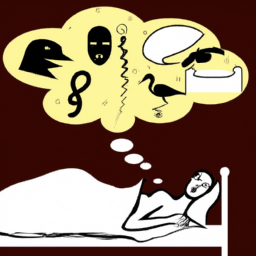I have always been intrigued by the vibrant and sometimes peculiar dreams that I experience during my sleep. Oftentimes, I wake up wondering about the potential significance of these dreams and what my subconscious mind may be trying to communicate to me.
One dream phenomenon that has recently captured my attention is shifting. So, what does shifting mean in dreams?
Shifting in dreams is a concept where an individual imagines themselves in another reality or dimension. It’s a popular topic on social media platforms like TikTok, where users share their experiences with shifting and the worlds they visit.
While some believe it’s just a form of lucid dreaming, others claim that it’s a way to visit alternate realities and manifest desires. In this article, we’ll explore the different types of shifting, theories of dream interpretation, common themes in shifting dreams, and techniques for analyzing and controlling them.
Key Takeaways
- Dream shifting can reveal subconscious desires and fears, providing insight into one’s emotional state and personal growth potential.
- Techniques such as dream analysis and control can help individuals harness the benefits of shifting dreams, such as enhanced creativity and problem-solving skills.
- Symbols and metaphors in dreams can hold potential meanings that may relate to real-life problems, making dreaming a useful tool for finding solutions.
- Keeping a dream journal can help identify patterns and problem areas in waking life, facilitating personal growth and self-awareness.
Definition of Shifting in Dreams
When I experience shifting in dreams, it’s like my consciousness is moving into a different reality where everything feels vivid and lifelike. It’s a unique feeling that’s hard to describe in words.
It’s as if I’m transported to a new world, with different rules and possibilities. During a shift, I feel like I have control over my surroundings and can manipulate them to my liking. It’s an exhilarating feeling, and I always look forward to experiencing it again.
There are different types of shifting, each with its own set of rules and characteristics. Let’s explore these different types of shifting and what they entail.
Different Types of Shifting
As you explore the different types of shifting, your mind will begin to conjure up vivid images of alternate realities and parallel universes. There are several types of shifting that one can experience in a dream, each with its unique characteristics and outcomes.
The most common type is reality shifting, where one can consciously or unconsciously manipulate their dream world to create a new reality. This can manifest in various ways, such as changing the environment, the people present, or even the laws of physics within the dream.
Another type of shifting is known as time shifting, where one can travel through different time periods in their dreams. This can be a fascinating experience as one can explore past events or even glimpse into the future.
Other types of shifting include dimension shifting, where one can travel to parallel universes or alternate dimensions, and self-shifting, where one can transform themselves into a different form or entity. All these types of shifting can provide insight into the workings of the human mind and the limitless possibilities of the dream world.
From here, we can delve into the theories of dream interpretation, where we can begin to understand the deeper meanings and messages hidden within our dreams.
Theories of Dream Interpretation
Now, I can delve into the fascinating world of dream interpretation theories and discover the hidden messages that my dreams hold.
There are countless theories about the meaning of dreams, but here are three of the most popular ones:
-
The Freudian theory suggests that dreams are a reflection of our unconscious desires and conflicts. According to Freud, our dreams reveal our repressed thoughts and feelings that we’re not aware of in our waking life.
-
The Jungian theory argues that dreams are a way for the unconscious mind to communicate with the conscious mind. Jung believed that dreams have a symbolic language that can help us better understand ourselves and our inner world.
-
The Activation-Synthesis theory proposes that dreams are simply the random firing of neurons in the brain during sleep. According to this theory, dreams don’t have any inherent meaning, but are simply the brain’s way of trying to make sense of the random signals it receives.
Understanding these theories can help me better interpret my dreams and uncover the hidden messages they hold. However, personal interpretation is also important as everyone’s dreams are unique and personal.
Personal Interpretation
When it comes to interpreting my dreams, I find it helpful to reflect on the emotions that come up during the dream. By identifying the emotions, I can better understand what my subconscious is trying to communicate.
Additionally, examining the personal triggers in my life that may have influenced the dream can also provide insight. Taking the time to examine my personal life and experiences can help me make sense of the symbols and themes present in my dreams.
Reflecting on Emotions
You can’t help but feel overwhelmed with emotions when you experience shifting in your dreams. It’s like you’re being transported to a different world, a reality that’s different from your own.
You feel a mix of excitement, fear, and uncertainty all at once. The intensity of these emotions can leave you feeling drained when you wake up in the morning.
Reflecting on these emotions can help you identify triggers that cause you to shift in your dreams. Perhaps you feel stressed or anxious about a particular situation in your waking life, and this is causing you to have vivid dreams.
Or maybe you’re feeling unfulfilled in your personal or professional life, and your subconscious is trying to tell you something through your dreams.
Whatever the reason may be, paying attention to your emotions can give you valuable insights into your inner world.
Identifying Triggers
By pinpointing the root causes of our emotional responses, we can gain deeper insight into what triggers our dream shifts. Identifying triggers is an important step in understanding our dreams, as it can help us address and resolve underlying issues that may be affecting us in our waking lives.
Here are five common triggers to consider:
- Stressful events or situations
- Repressed emotions or unresolved conflicts
- Changes in daily routine or environment
- Certain foods or medications
- Negative thought patterns or beliefs
By recognizing these triggers, we can begin to examine how they may be impacting our emotional state and ultimately our dreams. The next step is to delve into our personal lives and assess how these triggers may be manifesting in our daily experiences.
Examining Personal Life
After identifying triggers, examining my personal life can provide valuable insight into the underlying issues affecting my emotional state and dreams. It is important to reflect on my daily experiences, relationships, and emotions to determine any patterns or recurring themes that may be affecting my subconscious. To do this, I have created a table to organize my thoughts and observations:
| Personal Experience | Emotion/Feeling |
|---|---|
| Stressful work day | Anxiety |
| Argument with friend | Anger |
| Happy family outing | Joy |
| Feeling overwhelmed | Fear |
By examining this table, I can see that my emotional state is closely tied to my daily experiences. I may have anxiety dreams after a stressful work day, or angry dreams after an argument with a friend. Understanding these connections can help me better understand the root causes of my shifting dreams.
Moving on to the next section about common themes in shifting dreams, it is important to note that these themes may not always be directly related to my personal life.
Common Themes in Shifting Dreams
One of the most common themes in shifting dreams is the feeling of being in a different reality. It’s like being transported to a parallel universe, where everything looks and feels different.
In these dreams, I often find myself in an unfamiliar place, with unfamiliar people and surroundings. I can feel the confusion and disorientation, but also a sense of excitement and adventure.
As I explore these new surroundings, I often encounter strange and surreal experiences, which can be both terrifying and exhilarating. The dream world seems to follow its own set of rules, which can be both fascinating and unnerving.
Sometimes, I find myself facing impossible challenges, while other times, I discover new abilities and strengths that I never knew I had. These shifting dreams can leave me feeling unsure and disoriented upon waking up, but they also provide a glimpse into the limitless possibilities of the human imagination.
Transitioning into the subsequent section about interpreting specific scenarios, I’ve found that these shifting dreams can reveal a lot about my innermost desires and fears. By examining the specific scenarios and emotions that arise in these dreams, I can gain insight into my subconscious mind and the things that truly matter to me.
Interpreting Specific Scenarios
Now that I’ve explored common themes in my dreams, it’s time to delve deeper into specific scenarios and what they may reveal about my innermost desires and fears.
For instance, if I dream of shifting into a bird and flying high up in the sky, it could mean that I’m seeking freedom and the ability to soar above my problems.
On the other hand, if I dream of shifting into a monster and terrorizing others, it could mean that I’m struggling with negative emotions or feeling powerless in my waking life.
It’s important to remember that dream interpretation isn’t an exact science and that the meaning of a dream may vary based on personal experience and cultural background.
However, by analyzing the details of a dream and reflecting on my own emotions and experiences, I can gain insight into my subconscious desires and fears.
With this understanding, I can make positive changes in my waking life to align my actions with my innermost desires.
Now, let’s explore some techniques for analyzing dreams.
Techniques for Analyzing Dreams
When it comes to analyzing my dreams, I find that journaling, meditation, and therapy are the most effective techniques for gaining insight into my subconscious mind.
Journaling allows me to record and reflect on my dreams, while meditation helps me to quiet my mind and better connect with my inner thoughts and feelings.
And when I need extra guidance and support, therapy provides a safe space to explore my dreams and emotions with a trained professional.
Journaling
Keeping a dream journal can help me understand the meaning behind my dreams and is a great way to keep track of any recurring symbols or themes, making it easier to identify patterns and shifts in my subconscious mind.
When I wake up from a dream, I immediately jot down as much detail as possible, including any emotions or sensations I experienced. This helps me remember the dream better and allows me to analyze it later.
In addition to helping me understand my dreams, journaling also helps me practice mindfulness. By focusing on my dreams and writing them down, I’m able to stay present in the moment and connect with my inner self.
This is a great first step towards meditation, which is the next technique I use to analyze my dreams.
Meditation
To fully understand the messages your subconscious is trying to convey, you should try meditating on your dreams. Meditation can help you recall more details about your dreams and allow you to focus on their meaning.
When you meditate, you can clear your mind and gain a deeper understanding of what your dreams are trying to tell you. Meditation can also help you become more aware of your thoughts and emotions, which can be useful when interpreting your dreams.
By becoming more mindful, you can connect with your subconscious and gain a better understanding of yourself. However, if you find that meditation is not helping you understand your dreams, you may want to consider seeking therapy.
Therapy
If you’re struggling to make sense of what your subconscious is trying to tell you through your dreams, therapy could be the solution you need to unpack and process your emotions. A therapist can help you explore your dreams in a safe and supportive environment, and guide you through the process of identifying and working through any underlying issues that may be causing you to experience shifting dreams.
During therapy sessions, you may be encouraged to keep a dream journal, where you can record your dreams and any emotions or thoughts that come up for you. This can help you to identify patterns or recurring themes in your dreams, and give you a better understanding of what your subconscious is trying to communicate.
With the help of a therapist, you can learn to interpret your dreams and use them as a tool for personal growth and healing.
Now, let’s move on to some tips for controlling shifting dreams.
Tips for Controlling Shifting Dreams
I can share some tips on how to control shifting dreams.
One way is through reality checks, which involves questioning whether you’re in a dream or reality.
Another technique is lucid dreaming, where you become aware that you’re dreaming and can control the dream’s course.
Lastly, visualization can help you create a positive dream environment and steer your dreams in a certain direction.
Reality Checks
You’ll likely leap from lucid dreaming to reality by regularly performing reality checks. These checks can be anything that helps you distinguish dreaming from reality, such as pinching yourself or looking at a clock.
By making these checks a habit throughout your waking hours, you’ll be more likely to perform them in your dreams and realize that you are, in fact, dreaming. Once you’ve successfully performed a reality check in a dream, you can begin to explore the world of lucid dreaming.
Lucid dreaming allows you to control your dreams and experience things that may not be possible in real life. With practice and dedication, you can become a skilled lucid dreamer and unlock the full potential of your dream world.
Lucid Dreaming
To fully experience the wonders of lucid dreaming, it’s crucial to develop a consistent practice and immerse yourself in the dream state. Lucid dreaming is the state in which you become aware that you are dreaming, allowing you to take control of the dream and shape it according to your desires.
This is achieved through a range of techniques, such as reality checks, dream journaling, and meditation. Once you’ve developed a regular practice, you can begin to explore the possibilities of lucid dreaming, from flying through the sky to exploring new worlds.
One effective technique for enhancing your lucid dreaming experience is visualization. This involves imagining vivid, detailed scenes in your mind’s eye, which can then be brought to life in your dreams. By practicing visualization regularly, you can improve your ability to create and control dream scenarios, leading to more vivid and exciting dreams.
With dedication and practice, lucid dreaming can open up a whole new world of possibilities. It allows you to explore the depths of your subconscious mind and experience the limitless potential of the dream state.
Visualization
By practicing visualization regularly, I can enhance my lucid dreaming experience and gain the ability to create and control vivid dream scenarios. Visualization is the act of creating a mental picture or image in my mind. It can be done in a variety of ways, such as imagining a peaceful scene, visualizing a goal I want to achieve, or simply picturing myself in a specific situation.
When I use visualization techniques before falling asleep, I’m able to create a mental image of what I want to dream about. This can lead to a more vivid and memorable dream experience. Here are four visualization techniques I use to enhance my lucid dreaming experience:
- Create a clear mental image of what I want to dream about
- Focus on all five senses to make the dream experience more realistic
- Practice visualization regularly, even outside of dream scenarios
- Use positive affirmations to increase the likelihood of having a positive dream experience.
By incorporating these visualization techniques into my daily routine, I’ve been able to gain more control over my dreams and create more vivid and memorable experiences. These skills can also translate into my waking life, as visualization can be used to manifest goals and create a positive mindset.
In the next section, we’ll explore the potential benefits of shifting dreams.
Potential Benefits of Shifting Dreams
I personally believe that shifting dreams can have some potential benefits worth exploring.
Firstly, it can enhance creativity and imagination, allowing us to explore different scenarios and worlds beyond our waking life.
Secondly, it can also improve problem-solving skills, as we train our minds to think outside the box and find solutions to complex situations.
Lastly, shifting dreams may offer a form of emotional healing, giving us a safe space to process and work through our feelings.
Creativity and Imagination
You can unleash your creativity and imagination when exploring the meaning of shifting in your dreams. Dream shifting is a phenomenon where one can consciously control the direction of their dreams. This means that you can change the setting, characters, and even the outcome of your dream. By doing so, you can explore different possibilities and scenarios that you may not have thought of before.
One way to tap into your creativity and imagination is by using a table to organize your thoughts. In the left column, write down the elements of your dream that you remember. In the right column, write down the possibilities for each element. For example, if you dreamt of being in a forest, the possibilities could be that you are lost, searching for something, or discovering a hidden treasure. By exploring these possibilities, you can come up with new ideas and perspectives that you may not have considered before. This can lead to a greater sense of creativity and problem-solving skills in your waking life.
Exploring the meaning of shifting in your dreams can also help you develop problem-solving skills. By consciously controlling your dream, you can practice thinking outside of the box and finding solutions to complex problems. This can translate to your waking life, as you may find yourself approaching problems in a new and innovative way. Dream shifting can be a powerful tool for personal growth and development, as it allows you to tap into your inner creativity and problem-solving abilities.
Problem Solving
Problem solving in dreams is like a treasure hunt, where hidden clues and unexpected twists lead to solutions that may have been overlooked in waking life. It’s fascinating to see how our subconscious mind can come up with innovative and creative solutions to problems that we may have been struggling with for a long time.
In fact, I’ve personally experienced how dreaming has helped me find solutions to some of the most challenging problems I’ve faced. One of the most effective ways to utilize the problem-solving potential of dreams is to set an intention before going to bed. For example, if you’re stuck on a work project, you can ask yourself to dream about it and provide a solution.
Another great way is to keep a dream journal and write down your dreams every morning. This will help you identify patterns and themes that may reveal underlying problems or solutions. Finally, it’s essential to pay attention to symbols and metaphors in dreams, as they often hold valuable insights into our psyche.
By using these techniques, you can tap into the problem-solving power of your dreams and find solutions that you may have never thought possible. Dreams not only help us solve problems, but they can also aid in emotional healing.
Emotional Healing
Discovering ways to heal emotionally through dreaming can be a powerful tool for personal growth and well-being. Shifting in dreams is one such method that can help us process and release emotional baggage. When we shift in a dream, we move from one place or situation to another, often with a sense of ease and accomplishment. This can represent a shift in our waking life, where we are able to move past emotional blocks and find healing.
To better understand the concept of shifting in dreams, here is a table that illustrates some common dream symbols and their potential meanings in relation to emotional healing:
| Dream Symbol | Potential Meaning |
|---|---|
| Water | Emotions, cleansing, renewal |
| Mountains | Obstacles, challenges, strength |
| Bridges | Transitions, connections, overcoming obstacles |
| Trees | Growth, stability, grounding |
| Light | Clarity, insight, guidance |
By interpreting these symbols and exploring their potential meanings, we can learn to recognize and utilize the power of our dreams for emotional healing. Shifting in dreams can be a transformative experience, allowing us to let go of negative emotions and move towards a more peaceful and fulfilling life.
Frequently Asked Questions
Can shifting dreams be dangerous or harmful to the dreamer?
Shifting dreams can be potentially harmful to the dreamer if not done properly. It is important to consult with a professional and approach it with caution to avoid any negative consequences.
Is there any scientific evidence to support the concept of shifting in dreams?
There is no scientific evidence to support the concept of shifting in dreams. While some people may believe in the idea, it remains a topic of debate within the scientific community.
Can shifting dreams be induced intentionally, or do they only occur spontaneously?
I’m not sure if shifting dreams can be intentionally induced, but they seem to occur spontaneously. It’s possible that certain techniques or practices may increase the likelihood of experiencing a shifting dream, but more research is needed to confirm this.
Are there any cultural or regional differences in the way shifting dreams are interpreted or understood?
I’ve noticed that cultural and regional differences exist in the interpretation of dreams that involve shifts in reality. Some view it as a spiritual experience, while others see it as a warning of impending change.
Can shifting dreams be used as a tool for personal growth or self-discovery?
Yes, shifting dreams can unlock personal growth and self-discovery. Though some may dismiss it as mere imagination, the symbolism and emotions present in shifting dreams can reveal deep-seated fears, desires, and inner conflicts, offering valuable insights to the dreamer.
Conclusion
As I delve deeper into the world of shifting dreams, I realize that they hold a significant meaning in our lives. They’re not just random thoughts of our subconscious mind, but rather a manifestation of our fears, desires, and emotions.
Each dream carries a unique message that requires careful analysis and interpretation. Just like the different types of shifting dreams, we all have our own unique experiences and interpretations. The symbols in our dreams can be a reflection of our past, present, and future, and understanding them can provide us with valuable insights into our lives.
So, let’s embrace the mysteries of shifting dreams and use them as a tool for self-discovery and growth. As Carl Jung once said, "Your vision will become clear only when you can look into your own heart. Who looks outside, dreams; who looks inside, awakes."
Let’s awaken to the power of our dreams.









